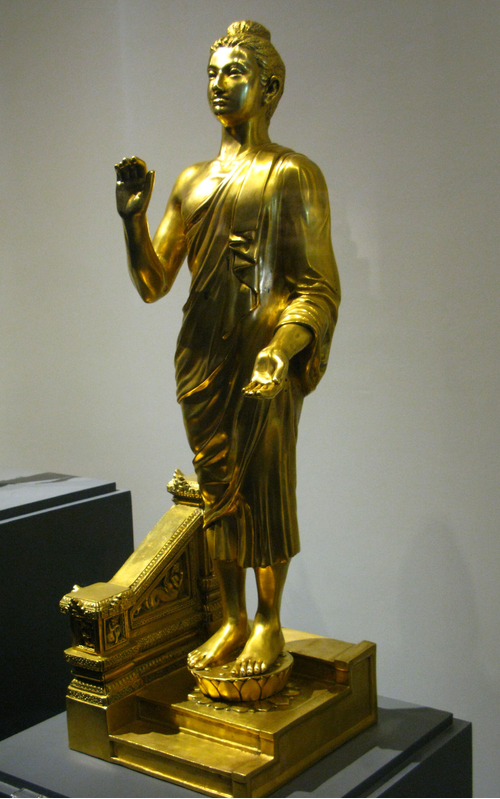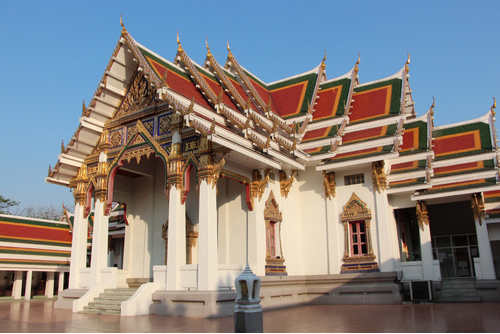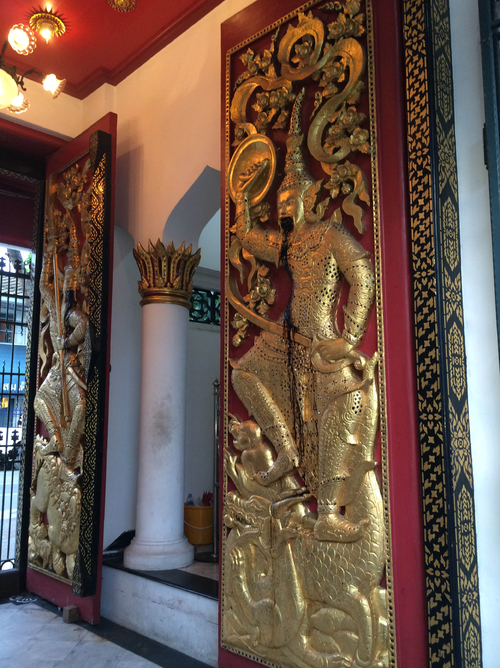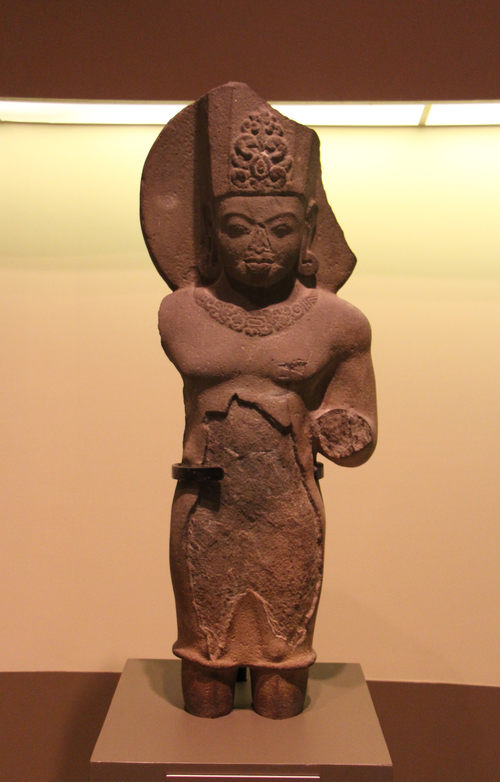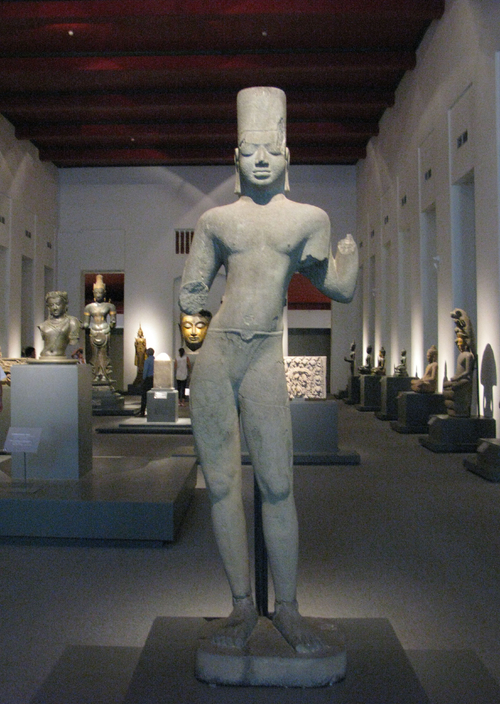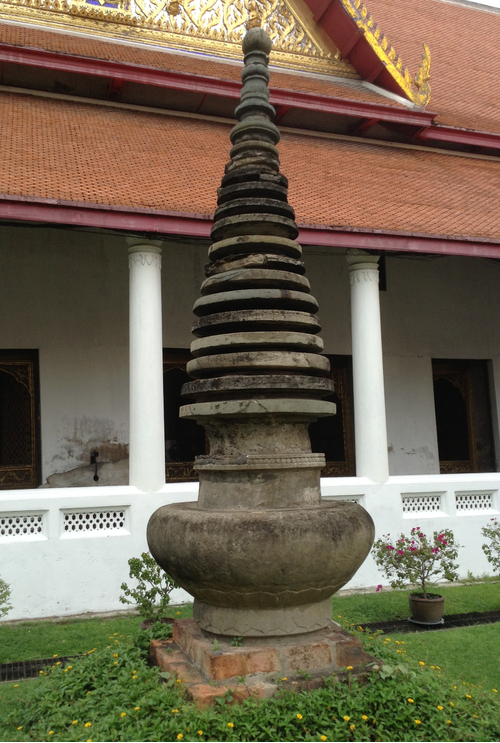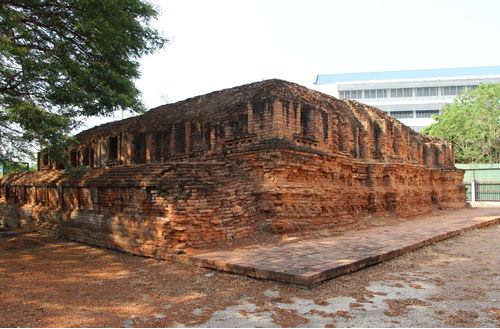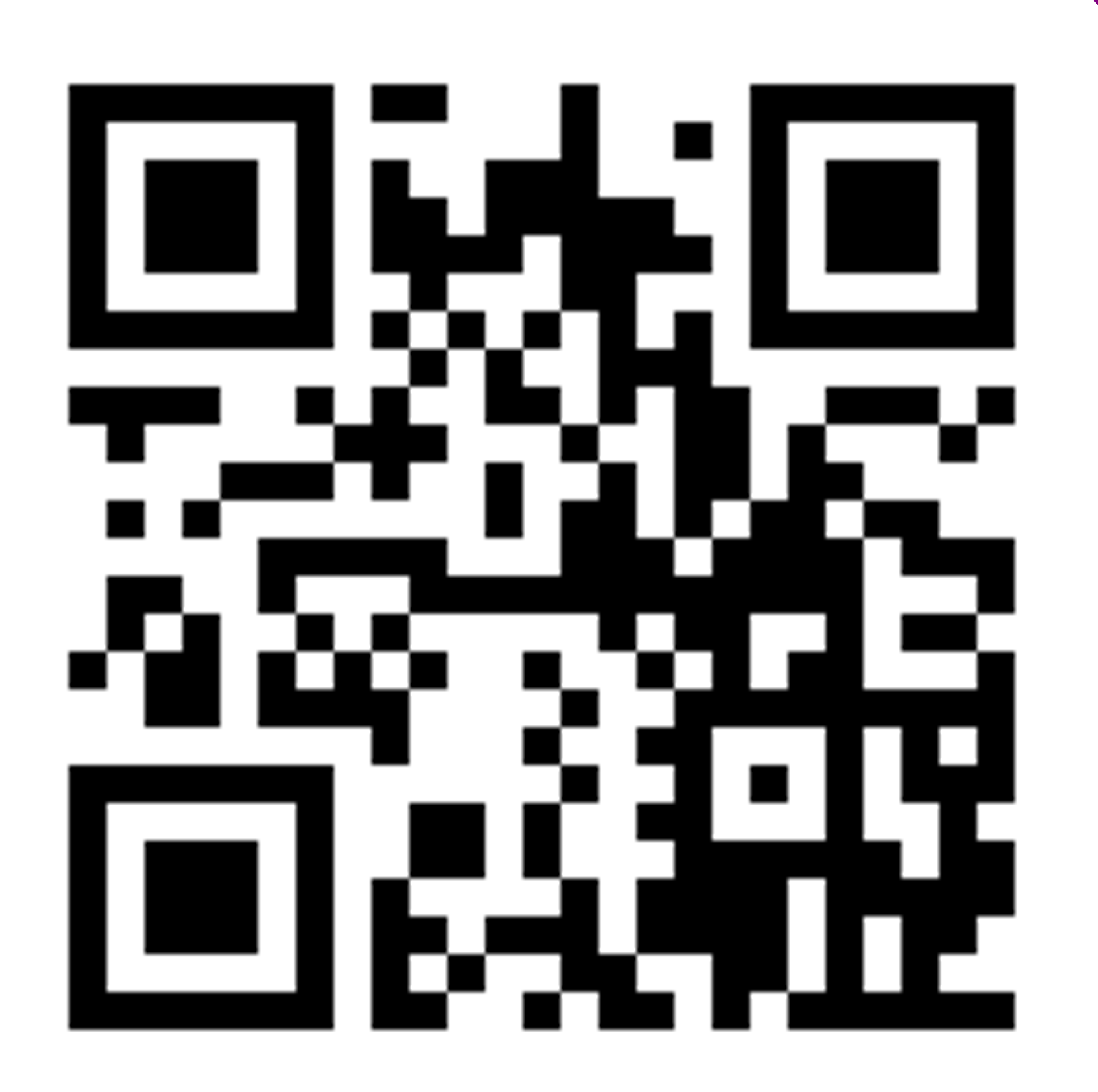ค้นหางานศิลปกรรม
ฐานข้อมูลศิลปกรรมในเอเชียตะวันออกเฉียงใต้
ประติมากรรมพระพุทธรูปคันธารราฐ
พระพุทธรูปเลียนแบบศิลปะอินเดียแบบคันธารราฐ ประทับยืนปางขอฝนพระพักตร์แหงนเงยขึ้นเบื้องบน พระหัตถ์ขวายกในกิริยากวัก พระหัตถ์ซ้ายหงายรองรับน้ำฝนตรงบั้นพระองค์พระพักตร์มีรูปแบบคล้ายเทพเจ้ากรีก-โรมัน เกล้าพระเกศาเป็นมุ่นโมลี ไม่มีพระรัศมี พระวรกายแสดงกล้ามเนื้ออย่างมนุษย์ ครองจีวรห่มเฉียงเป็นริ้วหนา มีรอยยับอย่างเป็นธรรมชาติ ประทับยืนบนดอกบัว เหนือบันไดขั้นบนสุดของขอบสระโบกขรณี ใกล้กันมีราวบันไดซึ่งมีเสาและพนัก ประดับตกแต่งรูปพระแม่ธรณีบีบมวยผม และรูปมนุษย์นาคซึ่งมีความหมายถึงน้ำ และความอุดสมบูรณ์
สถาปัตยกรรมอุโบสถวัดพระศรีมหาธาตุ บางเขน
พระอุโบสถก่ออิฐถือปูน แผนผังแบบจัตุรมุข มุขด้านตะวันตกประดิษฐานพระพุทธรูปประธาน มุขด้านเหนือและใต้เชื่อมต่อเป็นแนวระเบียงคดในผังสี่เหลี่ยมล้อมรอบพระอุโบสถ หลังคาซ้อนชั้นมุงกระเบื้องเคลือบสีประดับกรอบหน้าบันด้วยช่อฟ้า ใบระกา หางหงส์ และนาคสะดุ้งโดยมีโครงสร้างแบบคอนกรีต หน้าบันแต่ละทิศประดับลวดลายไทยที่มีลักษณะเรียบง่าย ไม่เน้นความอ่อนช้อย
สถาปัตยกรรมพระปั้นหย่า
พระปั้นหย่าเป็นสถาปัตยกรรมทรงตึกอย่างตะวันตกที่ผสมกับจีน ตัวอาคารก่ออิฐถือปูน แผนผังรูปสี่เหลี่ยมผืนผ้า อาคารสูง 3 ชั้น แต่ละชั้นมีลวดบัวขนาดใหญ่คาดรอบอาคารเพื่อแบ่งชั้นอาคารให้เห็นได้อย่างชัดเจน หลังคาพระปั้นหย่ามุงด้วยกระเบื้องและประดับหน้าบันด้วยกระเบื้องเคลือบแบบจีนเป็นรูปดอกไม้ใบไม้อย่างเทศ กลางหน้าบันประดับรูปพระมหามงกุฎ สองข้างขนาบด้วยฉัตร 5 ชั้น ซึ่งเป็นสัญลักษณ์แทนพระนามเจ้าฟ้ามงกุฎ ผนังอาคารภายนอกเรียบง่าย ไม่ประดับลวดลาย กรอบประตูหน้าต่างเป็นช่องสี่เหลี่ยม
ประติมากรรมประตูเสี้ยวกาง
ซุ้มประตูประกอบด้วยบานประตู 2 ชุด แต่ละชุดประกอบด้วยบานประตูสี่เหลี่ยมผืนผ้า 2 บาน พื้นสีแดง แต่ละบานสลักเป็นรูปทวารบาลอย่างจีนปิดทอง แต่งกายยืนเครื่องคล้ายทวารบาลแบบไทย ยืนเงื้อง่าถืออาวุธ ได้แก่ ง้าว ดาบ กริช โล่ อยู่บนหลังสัตว์ผสมต่างๆอย่างจีน รวมทั้งสิ้น 4 องค์ ที่ปากของทวารบาลแต่ละองค์แต่เดิมมีคราบยาฝิ่นสีดำติดอยู่เนื่องจากประชาชนทำมาป้ายถวายทวารบาล ในภายหลังได้มีการล้างทำความสะอาดคราบนั้นออก แต่ได้ทาสีดำไว้เพื่อแสดงถึงที่มาตามประวัติศาสตร์ ซึ่งลักษณะดังกล่าวเป็นเอกลักษณ์ของทวารบาลหรือเสี้ยวกางที่วัดบวรนิเวศวิหาร
ประติมากรรมพระสุริยเทพ
พระสุริยเทพองค์นี้ชำรุดเสียหายหลายส่วน ยืนตรง สวมกิรีฏมกุฏแปดเหลี่ยม หรือหมวกทรงกระบอกแปดเหลี่ยม มีลวดลายกนกประดับด้านหน้าของมกุฏ ประภามณฑลขนาดใหญ่อยู่เบื้องหลังพระเศียร ลักษณะทั้งสองนี้ทำให้ทราบว่าเป็นพระสุริยเทพหรือพระอาทิตยเทพพระพักตร์แบน สวมกุณฑลแบบห่วงกลมซึ่งพบได้ทั่วไปในประติมากรรมศิลปะทวารวดี สวมกรองศอที่มีลายกนกแบบทวารวดี พระองค์สวมผ้าแบบ Tonic เป็นชิ้นเดียวกันคลุมตั้งแต่พระอังสาจนจรดพระชานุ เป็นเครื่องทรงเฉพาะของพระสุริยเทพเข่นกัน พระกรทั้งสองข้างและพระบาททั้งสองข้างชำรุดสูญหาย จึงไม่ทราบรายละเอียดว่าเป็นอย่างไร
ประติมากรรมพระวิษณุ
พระวิษณุยืนเอียงพระโสณีอยู่บนฐานหน้ากระดาน สวมกิรีฏมกุฏหรือมกุฏทรงกระบอก บางท่านเรียกว่าหมวกแขก เป็นลักษณะหนึ่งที่พบได้ในรูปพระวิษณุรุ่นเก่า มีต้นแบบอยู่ในศิลปะอินเดียแบบปัลลวะพระวรกายส่วนบนเปล่าเปลือย พระกรทั้งสี่ชำรุดเสียหายจนไม่ทราบว่าถือสิ่งใดไว้ในพระหัตถ์ พระวรกายส่วนล่างนุ่งสมพตสั้นที่บางแนบเนื้อและไม่ประดับตกแต่งใดๆ จนแลดูกลมกลืนกับพระวรกาย ผ้านุ่งเช่นนี้สัมพันธ์กันกับประติมากรรมสำริดที่พบจากภาคอีสานตอนล่าง แถบจังหวัดนครราชสีมาและบุรีรัมย์พระองค์ยืนโดยให้น้ำหนักลงที่พระพระบาทขวา ในขณะที่พระบาทซ้ายหย่อน ทำให้พระโสณีเอียงไปทางขวา เรียกว่ายืนเอียงสะโพก มีต้นแบบมาจากการยืนตริภังค์ในศิลปะอินเดีย ซึ่งหมายถึงการยินเอียงสามส่วน ได้แก่ พระโสณี พระอังสา และพระเศียร พระวิษณุองค์นี้เป็นประติมากรรมลอยตัวอย่างแท้จริง ไม่มีแผ่นหินบริเวณข้อพระบาทเหมือนพระพุทธรูปทวารวดี และไม่มีชายผ้าหรือตะบองช่วยรับน้ำหนักเช่นพระวิษณุอื่นๆ การทำประติมากรรมลอยตัวเช่นนี้นับว่าเป็นความพิเศษของประติมากรรมจากเมืองศรีเทพ
สถาปัตยกรรมเจดีย์
ชิ้นส่วนดั้งเดิมของเจดีย์องค์นี้เริ่มต้นจากส่วนที่คล้ายหม้อน้ำ (อิฐที่รองรับเป็นของที่ทำขึ้นใหม่) อาจเป็นส่วนที่เทียบได้กับอัณฑะหรือองค์ระฆังของเจดีย์ทรงกลม ตอนล่างของส่วนที่คล้ายหม้อน้ำนี้ประดับด้วยกลีบบัวคว่ำบัวหงาย มีจารึกคาถาเย ธมฺมา ปรากฏอยู่ที่ตอนบนของส่วนที่คล้ายหม้อน้ำ ถัดขึ้นไปเป็นส่วนยอดซึ่งเริ่มต้นจากแท่งกลมหรือก้านฉัตร ถัดขึ้นไปเป็นแผ่นหินซ้อนดหลั่นกันและลำดับขนาดจากใหญ่ไปเล็ก ส่วนนี้คือฉัตรซ้อนชั้นนั่นเอง บนยอดสุดเป็นรูปลูกแก้วกลม
สถาปัตยกรรมเจดีย์จุลประโทน
เจดีย์จุลประโทนสร้างขึ้นจากอิฐ ได้รับการบูรณปฏิสังขรณ์มาแล้ว 1-2 ครั้งในอดีต สภาพปัจจุบันเหลือเพียงส่วนฐานและเรือนธาตุทึบตัน ส่วนยอดหักพังจนไม่เหลือร่องรอยแผนผังของฐานล่างสุดเป็นผังสี่เหลี่ยม ประดับด้วยเสาคั่นเป็นระยะ ระหว่างเสาแต่ละต้นประดับภาพปูนปั้นและดินเผาเล่าเรื่องชาดกในพุทธศาสนาและรูปอื่นๆ ปัจจุบันเคลื่อนย้ายไปยังพิพิธภัณฑสถานแห่งชาติ พระปฐมเจดีย์ แล้ว กึ่งกลางของแต่ละด้านเป็นบันไดขึ้นสู่ลานประทักษิณ ทั้งนี้ฐานส่วนนี้ปัจจุบันจมอยู่ใต้ดินองค์ประกอบชั้นถัดมาเดิมทีเคยอยู่ในผังสี่เหลี่ยมยกเก็จที่กลางด้านและที่มุม อันเป็นระเบียบทั่วไปของเจดีย์ทวารวดี แต่ต่อมาถูกก่อทับโดยฐานสี่เหลี่ยมที่ประดับด้วยบัววลัยหรือกลศและเสาคั่นเป็นระยะ ทำให้เกิดพื้นที่สี่เหลี่ยมระหว่างเสา ปัจจุบันฐานสี่เหลี่ยมนี้ปรักหักพังลงทำให้บางด้านสามารถมองเห็นฐานยกเก็จที่ซ้อนอยู่ภายในได้ ถัดขึ้นไปเป็นเรือนธาตุทึบตัน ประกอบด้วยซุ้มจระนำประดิษฐานพระพุทธรูปเรียงรายโดยรอบ พระพุทธรูปได้รับการเคลื่อนย้ายไปยังพิพิธภัณฑสถานแห่งชาติ พระปฐมเจดีย์ แล้ว ถัดขึ้นไปไม่ทราบว่าเป็นอย่างไร แต่ ศาสตราจารย์ ปิแอร์ ดูปองส์ สันนิษฐานว่าอาจซ้อนชั้นขึ้นไปเช่นเดียวกันกับเจดีย์กู่กุด อำเภอเมือง จังหวัดลำพูน
